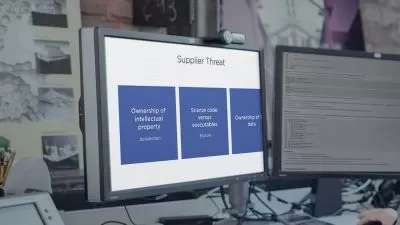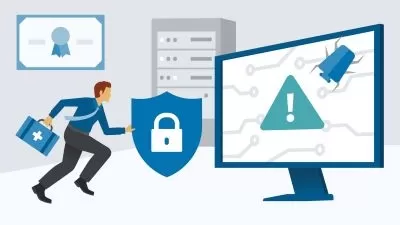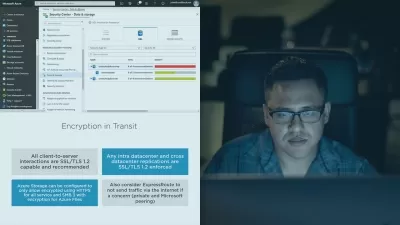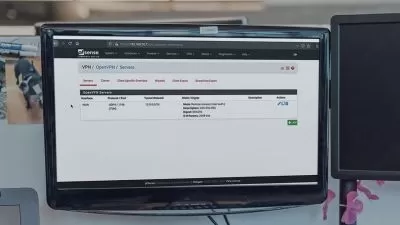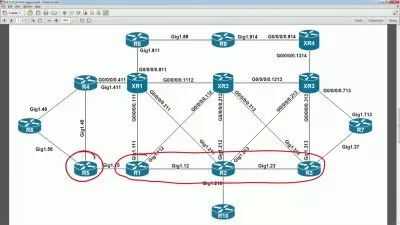01-01 - Course Overview -- Course Overview.mp4
03:30
02-01 - Preparing for Incident Response and Handling -- Course Introduction.mp4
06:42
02-02 - Preparing for Incident Response and Handling -- Security Policies and Their Goals.mp4
07:12
02-03 - Preparing for Incident Response and Handling -- Characteristics and Implementation.mp4
04:13
02-04 - Preparing for Incident Response and Handling -- Access Control Policy.mp4
01:56
02-05 - Preparing for Incident Response and Handling -- Acceptable Use Policy.mp4
01:40
02-06 - Preparing for Incident Response and Handling -- Administrative Security Policy.mp4
02:29
02-07 - Preparing for Incident Response and Handling -- Asset Control Policy.mp4
02:03
02-08 - Preparing for Incident Response and Handling -- Audit Trail Policy.mp4
02:08
02-09 - Preparing for Incident Response and Handling -- Logging Policy.mp4
01:56
02-10 - Preparing for Incident Response and Handling -- Documentation Policy.mp4
02:36
02-11 - Preparing for Incident Response and Handling -- Evidence Collection Policy.mp4
02:01
02-12 - Preparing for Incident Response and Handling -- Evidence Preservation Policy.mp4
02:13
02-13 - Preparing for Incident Response and Handling -- Information Security Policy.mp4
01:34
02-14 - Preparing for Incident Response and Handling -- NIACAP, IA, and CA Policy.mp4
01:14
02-15 - Preparing for Incident Response and Handling -- Physical Security Policy.mp4
02:00
02-16 - Preparing for Incident Response and Handling -- Physical Security Guidelines.mp4
01:22
02-17 - Preparing for Incident Response and Handling -- The Law in a Digital World.mp4
04:07
02-18 - Preparing for Incident Response and Handling -- Summary.mp4
01:32
03-01 - Incident Response Processes -- What We're Going to Learn.mp4
00:58
03-02 - Incident Response Processes -- What Is a Computer Security Incident.mp4
03:23
03-03 - Incident Response Processes -- How Do We Identify an Incident.mp4
03:44
03-04 - Incident Response Processes -- How Do We Handle an Incident.mp4
01:29
03-05 - Incident Response Processes -- So What's the Goal.mp4
02:12
03-06 - Incident Response Processes -- What's the Plan.mp4
02:56
03-07 - Incident Response Processes -- Information Warefare.mp4
03:59
03-08 - Incident Response Processes -- Vulnerability, Attacks, and Threats.mp4
05:54
03-09 - Incident Response Processes -- Signs of an Incident.mp4
09:47
03-10 - Incident Response Processes -- How Do We Respond.mp4
04:05
03-11 - Incident Response Processes -- The Team.mp4
03:31
03-12 - Incident Response Processes -- What Did We Learn.mp4
01:16
04-01 - The Workflow of Incident Response -- Understanding the Workflow.mp4
03:08
04-02 - The Workflow of Incident Response -- Identification.mp4
04:46
04-03 - The Workflow of Incident Response -- Incident Recording.mp4
01:04
04-04 - The Workflow of Incident Response -- Initial Response.mp4
01:59
04-05 - The Workflow of Incident Response -- Communicating the Incident.mp4
01:09
04-06 - The Workflow of Incident Response -- Containment.mp4
02:56
04-07 - The Workflow of Incident Response -- Formulating a Response Strategy.mp4
02:49
04-08 - The Workflow of Incident Response -- Incident Classification.mp4
01:46
04-09 - The Workflow of Incident Response -- Incident Investigation.mp4
01:18
04-10 - The Workflow of Incident Response -- Data Collection.mp4
01:40
04-11 - The Workflow of Incident Response -- Forensic Analysis.mp4
02:07
04-12 - The Workflow of Incident Response -- Evidence Protection.mp4
02:22
04-13 - The Workflow of Incident Response -- Notifying External Agencies.mp4
00:53
04-14 - The Workflow of Incident Response -- Eradication.mp4
05:42
04-15 - The Workflow of Incident Response -- System Recovery.mp4
01:43
04-16 - The Workflow of Incident Response -- Incident Documentation.mp4
01:42
04-17 - The Workflow of Incident Response -- Incident Damage and Cost Assessment.mp4
01:48
04-18 - The Workflow of Incident Response -- Review and Update the Response Policies.mp4
01:17
04-19 - The Workflow of Incident Response -- What Did We Learn.mp4
00:35
05-01 - Networks and Host Attacks -- What We're Going to Learn.mp4
00:38
05-02 - Networks and Host Attacks -- Denial of Service Handling.mp4
04:31
05-03 - Networks and Host Attacks -- Denial of Service Detection.mp4
05:21
05-04 - Networks and Host Attacks -- Denial of Service Handling.mp4
02:40
05-05 - Networks and Host Attacks -- Denial of Service Responding.mp4
02:20
05-06 - Networks and Host Attacks -- Denial of Service Prevention.mp4
02:21
05-07 - Networks and Host Attacks -- Denial of Service Containment.mp4
02:41
05-08 - Networks and Host Attacks -- Denial of Service Best Practices.mp4
01:24
05-09 - Networks and Host Attacks -- Unauthorized Access Handling.mp4
06:45
05-10 - Networks and Host Attacks -- Unauthorized Access Signs of a Root Compromise.mp4
04:17
05-11 - Networks and Host Attacks -- Unauthorized Access Hardware.mp4
02:21
05-12 - Networks and Host Attacks -- Unauthorized Access Responding.mp4
01:31
05-13 - Networks and Host Attacks -- Unauthorized Access Prevention.mp4
04:25
05-14 - Networks and Host Attacks -- Unauthorized Access Responding.mp4
01:44
05-15 - Networks and Host Attacks -- Unauthorized Access Eradicate and Recovery.mp4
01:20
05-16 - Networks and Host Attacks -- Unauthorized Access Best Practices.mp4
02:32
05-17 - Networks and Host Attacks -- Inappropriate Usage Detecting.mp4
03:42
05-18 - Networks and Host Attacks -- Inappropriate Usage Prevention.mp4
02:45
05-19 - Networks and Host Attacks -- Inappropriate Usage Containment.mp4
01:19
05-20 - Networks and Host Attacks -- Multiple Components Issues Handling.mp4
01:51
05-21 - Networks and Host Attacks -- Multiple Components Issues Responding.mp4
01:04
05-22 - Networks and Host Attacks -- What Did We Learn.mp4
01:29
06-01 - Service and Application Attacks -- _What We're Going to Learn.mp4
00:58
06-02 - Service and Application Attacks -- Service and Application Monitoring.mp4
01:52
06-03 - Service and Application Attacks -- Some Symptoms Services.mp4
02:09
06-04 - Service and Application Attacks -- Demo Checking Services.mp4
08:20
06-05 - Service and Application Attacks -- Demo Application Error Monitoring.mp4
04:17
06-06 - Service and Application Attacks -- Analysis Applications.mp4
01:20
06-07 - Service and Application Attacks -- Service and Application Response and Restore.mp4
01:47
06-08 - Service and Application Attacks -- Detecting the Attacks Applications.mp4
04:06
06-09 - Service and Application Attacks -- Types of Attacks Session Hijacking.mp4
01:31
06-10 - Service and Application Attacks -- Demo Session Hijack.mp4
03:30
06-11 - Service and Application Attacks -- Symptoms Session Hijacking.mp4
04:23
06-12 - Service and Application Attacks -- Defense Session Hijacking.mp4
02:32
06-13 - Service and Application Attacks -- When It Happens Session Hijacking.mp4
01:10
06-14 - Service and Application Attacks -- Types of Attacks Command Injection.mp4
05:34
06-15 - Service and Application Attacks -- Defense SQL Injections.mp4
02:51
06-16 - Service and Application Attacks -- When It Happens SQL Injection.mp4
02:23
06-17 - Service and Application Attacks -- Types of Attacks XSS Attacks.mp4
01:08
06-18 - Service and Application Attacks -- What Attackers Are Looking For XSS Attacks.mp4
02:49
06-19 - Service and Application Attacks -- Types of XSS Attacks.mp4
01:46
06-20 - Service and Application Attacks -- Tools XSS Attacks.mp4
01:09
06-21 - Service and Application Attacks -- Defense XSS Attacks.mp4
02:43
06-22 - Service and Application Attacks -- When It Happens XSS Attacks.mp4
01:03
06-23 - Service and Application Attacks -- Types of Attacks Buffer Overflow.mp4
02:29
06-24 - Service and Application Attacks -- Types of Buffer Overflows.mp4
01:10
06-25 - Service and Application Attacks -- Tools Buffer Overflows.mp4
01:59
06-26 - Service and Application Attacks -- Defense Buffer Overflows.mp4
02:42
06-27 - Service and Application Attacks -- When It Happens Buffer Overflows.mp4
01:07
06-28 - Service and Application Attacks -- What Did We Learn.mp4
01:19
07-01 - Malicious Code and Insider Threats -- What We're Going to Learn.mp4
01:13
07-02 - Malicious Code and Insider Threats -- Malicious Code Virus and Worms.mp4
02:19
07-03 - Malicious Code and Insider Threats -- Malicious Code Trojans and Spyware.mp4
02:35
07-04 - Malicious Code and Insider Threats -- Malicious Code What to Do.mp4
04:00
07-05 - Malicious Code and Insider Threats -- Malicious Code What Are the Signs.mp4
02:02
07-06 - Malicious Code and Insider Threats -- Malicious Code Containment.mp4
03:10
07-07 - Malicious Code and Insider Threats -- Malicious Code Gather Evidence.mp4
01:48
07-08 - Malicious Code and Insider Threats -- Malicious Code Bots and Botnets.mp4
02:37
07-09 - Malicious Code and Insider Threats -- Malicious Code How Bots and Botnets Work.mp4
05:11
07-10 - Malicious Code and Insider Threats -- Incident Response Handling Performing.mp4
02:18
07-11 - Malicious Code and Insider Threats -- Malicious Code Rootkits in Windows.mp4
02:54
07-12 - Malicious Code and Insider Threats -- Malicious Code Rootkits - Kernel Mode.mp4
01:06
07-13 - Malicious Code and Insider Threats -- When It Happens Rootkits.mp4
01:59
07-14 - Malicious Code and Insider Threats -- Prevention Rootkits.mp4
03:22
07-15 - Malicious Code and Insider Threats -- Insider Threats The Landscape.mp4
01:42
07-16 - Malicious Code and Insider Threats -- Insider Threats The Workflow.mp4
01:12
07-17 - Malicious Code and Insider Threats -- Insider Threats Detection and Response.mp4
02:55
07-18 - Malicious Code and Insider Threats -- Insider Threats Prevention - Network Level.mp4
01:30
07-19 - Malicious Code and Insider Threats -- Insider Threats Prevention - Access Control.mp4
01:31
07-20 - Malicious Code and Insider Threats -- Insider Threats Prevention - Awareness Program.mp4
01:42
07-21 - Malicious Code and Insider Threats -- Insider Threats Prevention - Admins and Privileged Users.mp4
02:47
07-22 - Malicious Code and Insider Threats -- Insider Threats Prevention - Backups.mp4
01:33
07-23 - Malicious Code and Insider Threats -- What Did We Learn.mp4
01:22







